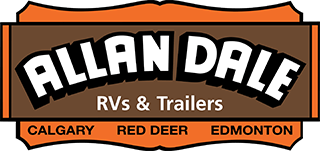How to Safely Tow Large Trailers
 Some recreational vehicles are compact and light, so they’re not that much different than simply driving your car.
Some recreational vehicles are compact and light, so they’re not that much different than simply driving your car.
But many large towable trailers can be a challenge to tow because they’re not only heavier in weight, but they’re also much longer and wider.
In order to tow them, you’ll need to adjust your driving style, have the right towing vehicle and ensure that you’re taking all the necessary precautions to keep yourself, your passengers and other drivers on the road safe. Allan Dale Trailers & RVs has provided some basic best practices for safely towing large trailers. If you’re looking to buy an RV or utility trailer, visit us at our dealership in Red Deer and Edmonton, Alberta, to check out our selection of trailers for sale.
Choose the Right Towing Vehicle
The most important priority is to ensure that you have the correct towing vehicle for the size of the trailer you plan to tow. Not every vehicle can handle the extra weight, so you need to be selective and do your research. Check the gross combined weight rating (GCWR) of your towing vehicle, which is set by the manufacturer and refers to the maximum weight limit that the truck or car can handle, including the vehicle itself, any towed vehicles, all cargo, and passengers. You’ll find this listed on the passenger side door or in the owner’s manual.
Exceeding the GCWR is extremely dangerous. You’re also required by law to comply with weight restrictions when towing, which is for the safety of you as well as others on the road. Towing too much weight behind your vehicle can result in tire blowouts, swaying or damage to your vehicle’s suspension system. If caught by law enforcement, you’ll face a hefty fine, so it’s just not worth it!
Distribute Weight Evenly
Loading up your trailer correctly ensures that it’s balanced properly. A trailer with too much weight on one side presents a serious safety hazard, as the heavier side could result in bursting a tire. You may also struggle to keep the trailer straight while driving due to the imbalance.
Distribute all weight evenly from side to side in your trailer. You’ll probably have to spend some time planning how to load up your trailer in order to achieve this, but it’s time well spent, as it ensures everyone’s safety and reduces the risk of doing damage to your towing vehicle or your trailer. When towing a very large trailer, you can even consider installing a weight-distribution hitch.
Practice Your Driving Skills
If you’re new to towing, it pays to put in some practice before you set out on your camping trip. You don’t want to make the day of departure the very first time you drive your trailer. Take some time in advance of your trip to hitch up your rig and drive to an empty parking lot where you can practice turning, braking, reversing and parking your towing setup. Of course, you’re used to doing these tasks easily enough in your vehicle alone, but the trailer will change things significantly.
Once you’re confident in these skills, you should also try merging onto the highway to practice driving at higher speeds while towing. Choose a time of day where traffic is at a minimum, not rush hour, so you won’t feel as much pressure from surrounding vehicles. Ensure that you’re leaving enough space around your tow vehicle and trailer. You may want to double your following distance because the added weight will mean that coming to a full stop takes more time.
Stick to the right-most lanes of traffic and try not to switch lanes, allowing other vehicles to pass you. You’ll likely be going five to ten miles slower than they are since large trailer tires aren’t really made to go much over 60 mph.
With some time and practice, you can safely tow a large trailer. If you haven’t found the trailer that best suits your lifestyle, you’ll want to visit our dealership! Stop by Allan Dale Trailers & RVs in Red Deer and Edmonton, AB, to explore our selection of large trailers for sale. We proudly serve those throughout Alberta.


